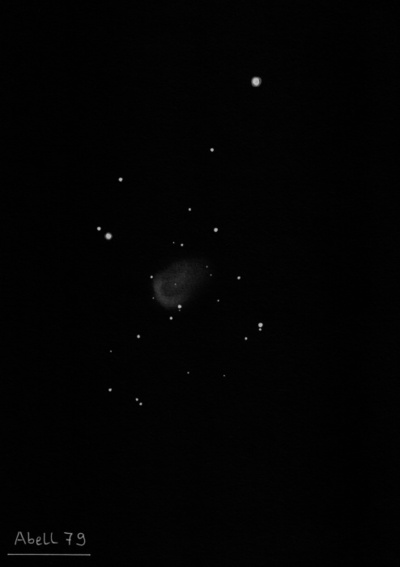A faint minor constellation of the northern sky, lying on the edge of the Milky Way between Cygnus, Pegasus, Cepheus and Andromeda. The northern part is circumpolar in our latitudes, southernmost except for northern Europe. This constellation consists only of a zigzag chain of faint stars denoted by Arabic numerals, so that the Lacerta is rather faint. Since its northern half lies in the Milky Way, it contains several open clusters suitable for small telescopes. The constellation is interesting because three novae were observed in it in the 20th century: in 1910, 1936, and 1950. The 1936 one (CP Lacertae) flared in the northernmost part of the constellation and was known as "Nova Lacertae". It was discovered on June 16 of the same year by the Czech astronomer Záviš Bochníček, who also worked in Slovakia. At the time of the flare, it reached a brightness of 2.2mag in three days, which was 175,000 times its original brightness and 300,000 times the brightness of the Sun. It was a typical example of a so-called fast nova. To this day, it has become a faint white dwarf of 14.8mag, unobservable with ordinary amateur telescopes. It's 5,400 light years away. Nova 1910 (DI Lac) reached a brightness of 4.3mag. The faintest of these was the 1950 nova (DK Lac), which brightened to 5mag.
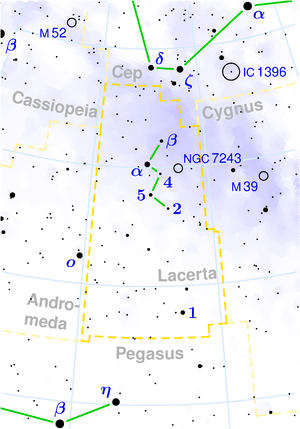
8 Lac - Struve 2922 has so many companions that it could be classified as a poor open star cluster rather than just a multiple star. Four close companions, all white or pale blue components, lie within 82" of the primary star. Another one lies 336" WSW. There are also stars of magnitude 13-14 in the area. A minimum of a 200mm telescope is required for sufficient enjoyment of the view.
Struve 2902 - Multiple star, brighter 6.4" close pair consists of a yellow component (7.6mag) and a white component (8.5mag). The second pair is located northeast and consists of two components with brightness of 12.1mag and 12.9mag at a separation of 5". In the same field of view, there are two more pairs. One in a closer separation, the other in a wider separation. To explore the surroundings, a telescope with a 150mm objective diameter is needed.
Struve 475 - nice unequally bright double star (6.8mag and 10.8mag). The brighter star has a white color, the fainter companion located at a separation of 15.5" is bluish. Immediately southwest, there is a faint pair of two components.
NGC 7243
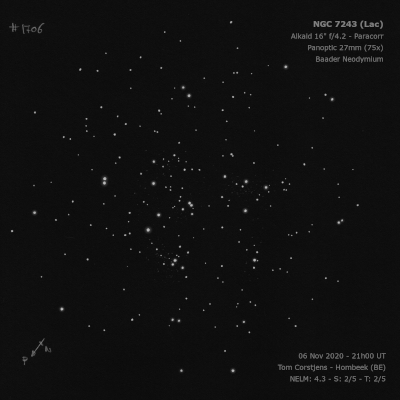
William Herschel discovered NGC 7243 = H VIII-75 = h2155 on 26 Sep 1788 (sweep 863) and recorded "an extended cluster of coarsely scattered vL stars, in the direction of the parallel nearly; about 16' long." JH made the single observation "a double star in a very loose straggling cl, which more than fills the field."
300/350mm - 13.1" (9/22/84): about 80 stars resolved, rich, fairly large, excellent low power field, includes double star ∑2890.
400/500mm - 17.5" (10/12/85): at 83x, 150-200 stars are visible in a 20' field. This is a striking cluster at low power and includes a number of fairly bright stars. On the east side is the nice pair ∑2890 = 9.3/9.6 at 9". The cluster is irregularly distributed into subgroups.
Notes by Steve Gottlieb
NGC 7209
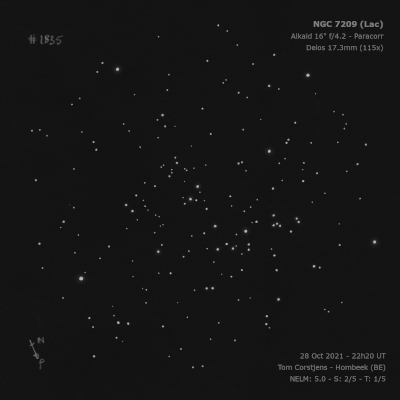
William Herschel discovered NGC 7209 = H VII-53 = h2147 on 19 Oct 1788 (sweep 868) and recorded "a large cl. of pretty compressed considerable L stars, above 15' diameter." JH made two observations, first recording on sweep 209, "place of a * 10m near the middle of a fine L p rich cluster; 50 stars from 10m to 13m counted. It fills field. Moon full."
200/250mm - 8" fairly large, spread out, similar magnitudes. Framed by an 8th magnitude star.
300/350mm - 13.1" (9/22/84): about 75 stars, bright, fairly scattered.
400/500mm - 17.5" (10/12/85): 100-125 stars are resolved, bright, large. Located in a very rich field so does not stand out conspicuously.
Notes by Steve Gottlieb
IC 1434
Rev. Thomas Espin discovered IC 1434 around 1893 with his 17.3-inch reflector at his private observatory in England while sweeping for red stars. He recorded "A remarkable cluster with six distinct radiating branches. Stars from 12 to 15." His rough position is fairly accurate. IC 1434 was confirmed as an open cluster in 2011A&A...530A..32B ("Star clusters or asterisms? 2MASS CMD and structural analyses of 15 challenging targets.") at a distance of roughly 8500 +/- 2000 light years.
200/250mm - 8" (8/12/83): ~50 stars at 200x, over haze, includes two strings on the east side, brighter stars at the south edge.
400/500mm - 17.5" (7/29/92): about 100 stars in a 15' diameter. Three mag 9 stars form a triangle on the south side. The extensions almost fill the 20' field. Long sprays of stars intersect near the center at a mag 10.5 star. A long ray extends ENE for 11' and contains 30 stars. A ray to the WSW of 11' length has 16 stars including a close triple star. There are two more sprays to the NW of 6' length. The cluster has no distinct borders. The surrounding Lacerta Milky Way region is breathtaking with a 20 mm Nagler. Located 2.1° WNW of mag 4.4 Beta Lacertae.
Notes by Steve Gottlieb
IC 1442
Rev. Thomas Espin discovered IC 1442 in 1893 with his 17-inch reflector at his private observatory in England (no specific day given in his discovery paper). He recorded "haze round some dozen faint stars." His position is about 5' too far northeast and this error was repeated in modern sources.
Cederblad catalogued this object as Ced 202 based on the IC description of "Cl of neb stars", but there is no nebulosity.
400/500mm - 17.5" (8/5/94): about three dozen stars in a distinctive curving row oriented SW-NE about 4' diameter with fainter loops at both ends. A mag 9 star SAO 34248 is off the SE and a mag 10 star SAO 34250 is off the NE end. Unconcentrated but stands out well at low power (100x). Located 20' SE of NGC 7245.
Notes by Steve Gottlieb
NGC 7245
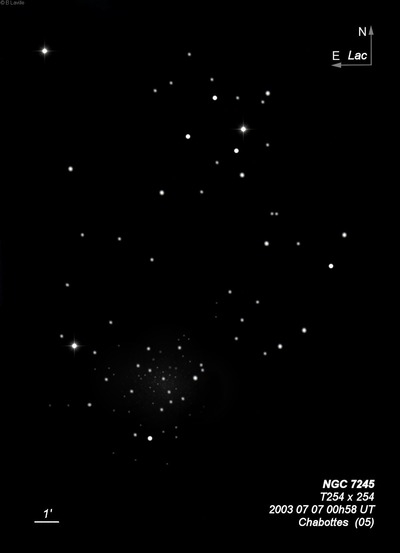
William Herschel discovered NGC 7245 = H VI-29 = h2157 on 14 Oct 1787 (sweep 765) and noted "a compressed cluster of extremely small stars." JH made the single observation "a Milky Way cluster. Stars 14...15m. It is more crowded than the Milky Way, so as to run up to a condensed but faint mass of light." His position is accurate.
200/250mm - 8" 15 faint stars elongated N-S with a double star at the north edge. Includes three brighter stars mag 8-10 around the edges but the rest of the stars are mag 13 or fainter.
300/350mm - 13.1" (9/9/83): about 20 fainter stars mostly in a string. Other rich enhancements are near in this Milky Way field.
400/500mm - 17.5" (8/5/94): about two dozen stars in a 2.5' diameter bordered by a mag 11 star on the west edge, a mag 10 star on the SSE edge and a mag 9 star (SAO 34240) off the NE side. A small 1' diameter core is richer. A large dust lane appears to cut through the 20' field SW-NE and passes the east side of cluster. At low power other dark patches are evident. Open cluster IC 1442 is in the low power field 20' SE.
Notes by Steve Gottlieb
IC 5217
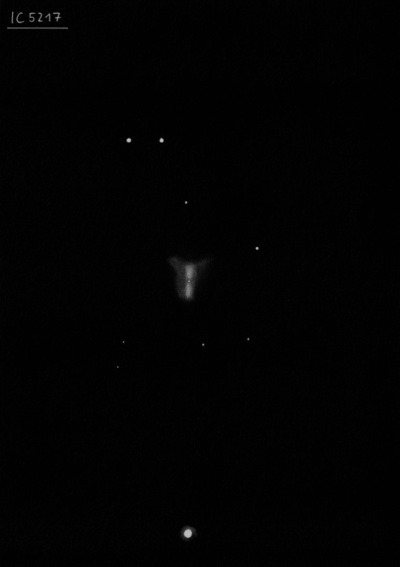
Williamina Fleming discovered IC 5217 = Fleming 102 in 1904 based on its emission line spectrum on a Harvard plate. Several visual observations were made by Thomas Espin in 1911 with his 17.25" reflector and he estimated the size from 2.5" to 4" in diameter and "apparently elongated N and S."
Based on Crossley photographs taken at Lick, Heber Curtis (1918) reported "no central star can be distinguished. A bright oval about 7.5"x6" in a 5 min exposure; slightly larger and quite "square-shouldered" in the long exposure. Brighter along the middle, but no details of structure can be made out."
200/250mm - 8" stellar planetary at 100x, slightly fuzzy at 220x and an easy ellipse is visible at 400x.
300/350mm - 13.1" (10/10/86): at 166x appears fairly bright but just non-stellar. Good contrast gain with OIII filter. A bright compact bluish disc is visible at 214x, slightly elongated. Estimate V = 11.5 and 5" diameter. Located 1.3° due south of mag 4.4 Beta Lac.
400/500mm - 18" (7/2/08): picked up easily at 174x as a "soft" mag 11.5 with a pale blue color. Good contrast gain blinking with an OIII filter. A brighter mag 10 comparison star lies 1.8' S but blinking with the filter the planetary switches apparent brightness with this star. At 435x, IC 5217 appeared as a 7"x5" blue disc, slightly elongated SSW-NNE. With direct vision, a slightly brighter quasi-stellar center was visible suggesting the central star was just below the threshold of visibility.
18" (12/08/07): picked up at 115x as a soft blue-grey "star". Good contrast gain using a NPB filter. Without a filter, a brighter mag 10 star lies to the south though with the filter the planetary matches the star. At 225x a definite small disc was visible, crisp-edged, round, ~6" diameter. The seeing was too soft to use high power.
Notes by Steve Gottlieb
NGC 7296
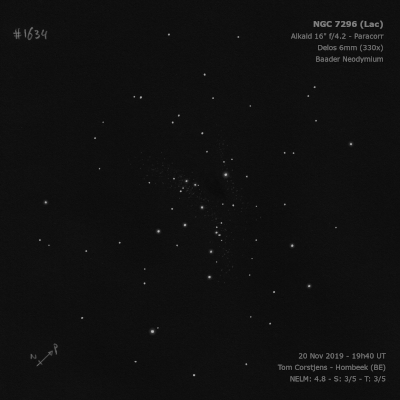
William Herschel discovered NGC 7296 = H VII-41 on 14 Oct 1787 (sweep 765) and noted "a small cluster of stars, not very rich; like a forming one." His RA was 40 seconds too large.
200/250mm - 8" (11/8/80): 15 stars extended N-S between two mag 8 and 9 stars. Appears faint and small with an unresolved background haze.
400/500mm - 17.5" (10/5/91): compact group of roughly 30 stars in a 3'x2' area elongated N-S. A mag 9 star is at the NW edge. Most stars are arranged in a curved arc roughly N-S. A string of four perfectly collinear stars trail from this arc to the NE. Not particularly distinctive as located in a rich star field. Contains about ten faint stars mag 14-14.5. Located 40' E of Beta Lacertae (V = 4.4).
Notes by Steve Gottlieb
NGC 7250
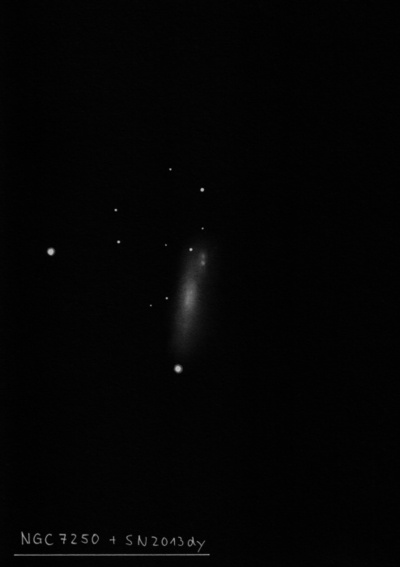
William Herschel discovered NGC 7250 = H III-864, along with NGC 7248, on 8 Nov 1790 (sweep 977) and recorded "vF; S; mE; 300 showed it very plainly. The extension from about 75° np to sf; bM." His position is 12 seconds of RA too large (typical error).
300/350mm - 13.1" (8/24/84): fairly faint, very elongated streak NNW-SSE, small bright core. A mag 11 star is off the SSE tip 0.9' from center. Pair with NGC 7248 17' WSW. This galaxy may be an interacting double system but it was not resolved.
400/500mm - 18" (10/19/06): fairly faint, fairly small, very elongated NNW-SSE, 0.6'x0.2', very small bright core. A mag 11 star is just off the SSE end. The galaxy fades at the tips, so the full extent was difficult to determine but appears to extend to 1.0'x0.25'. A very faint knot (PGC 214816) is occasionally visible at the NNW end. This nearly stellar "knot" is often noted as an interacting companion, though it may be a bright HII complex in the galaxy. NGC 7250 is classified as a starburst galaxy.
600/800mm - 24" (9/2/16): at 200x; this disrupted galaxy or interacting pair appeared moderately bright, elongated 5:2 N-S, 0.7'x0.3', bright core. A small, very faint knot or extension is at the north end. A mag 10.9 star is 0.9' SE of center. At 375x; the "knot" attached on the west side of north end of the galaxy extends ~20"x10" NNW-SSE (slightly different PA than the main galaxy), increasing the total size of the merged glow to nearly 1.0'x0.3'. HyperLeda catalogues the object at the north end as a galaxy (PGC 214816), though on the SDSS it appears to be a collection of blue knots. NGC 7248 is 17' WSW.
24" (8/7/13): moderately bright, fairly small, elongated 5:2 N-S, 0.75'x0.3', sharply concentrated with a very small brighter nucleus. A mag 11 star is just off the SSE edge. The structure at the north end was masked by Type-Ia supernova 2013dy at mag 13-13.5, which was discovered on July 10th, a couple of weeks before maximum. The supernova was 2" W and 25" N of the nucleus of NGC 7250.
Notes by Steve Gottlieb
NGC 7264
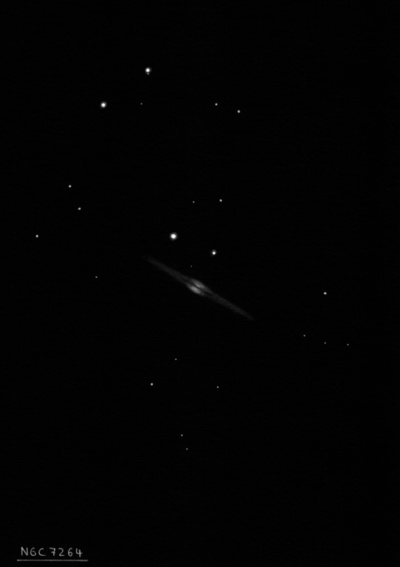
Albert Marth discovered NGC 7264 = m 475 on 17 Sep 1863 and noted "vF, pS, mE." His position is accurate.
400/500mm - 17.5" (8/12/88): faint, fairly small, very elongated SW-NE. A wide double star mag 12/13 at 34" separation is less than 1' N. Pair with NGC 7263 6.1' WSW.
600/800mm - 24" (9/14/12): fairly faint but excellent thin edge-on 6:1 SW-NE, ~1.2'x0.2', slightly brighter core, very thin extensions. Two mag 11.6/13.3 stars parallel the galaxy off the north side. NGC 7263 is 6.1' WSW and NGC 7265 (brightest in a small quartet) is 11' SSE.
Notes by Steve Gottlieb
Me 2-2
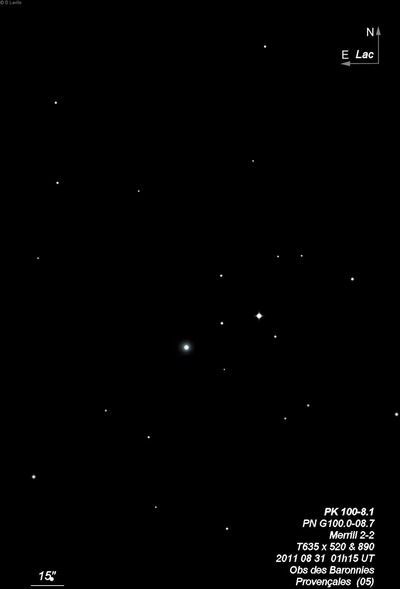
| Type | PN |
| RA | 22:31:43.7 |
| Dec | +47:48:04.0 |
| minor_axis | 48.0'' |
| mag | 11.9 |
| surface_bright | 6.2 |
M 2-53
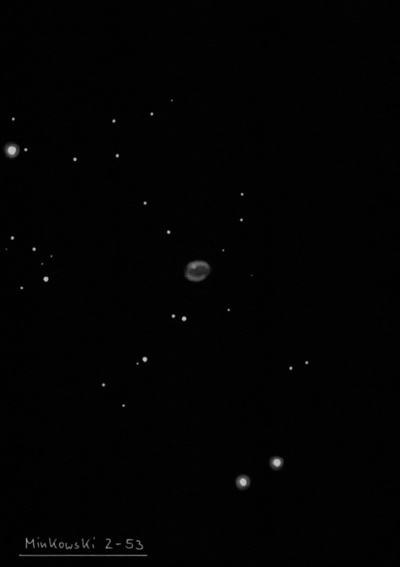
| Type | PN [3b] |
| RA | 22:32:17.7 |
| Dec | +56:10:26.0 |
| major_axis | 24.0'' |
| minor_axis | 18.0'' |
| mag | 14.9 |
| surface_bright | 12.2 |
Abell 80
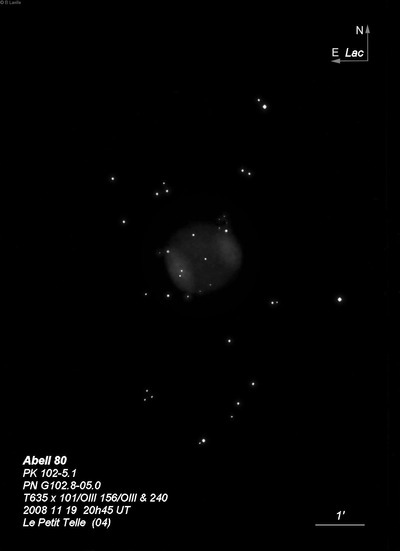
| Type | PN |
| RA | 22:34:45.6 |
| Dec | +52:26:06.0 |
| major_axis | 2.7' |
| minor_axis | 2.0' |
| mag | 15.2 |
| surface_bright | 16.8 |
